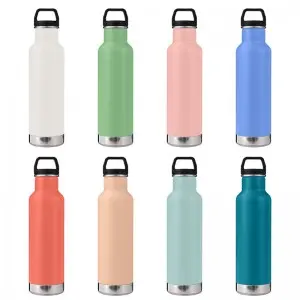Introduction
In an era where environmental consciousness is paramount, the market for sustainable products is flourishing. Recycled stainless steel water bottles have emerged as a beacon of hope, offering a perfect blend of eco-friendliness and functionality. For exporters venturing into this niche, understanding the market landscape, consumer preferences, and strategic approaches is crucial for success. This comprehensive blog post delves into the vast opportunities awaiting exporters of recycled stainless steel water bottles, providing insights tailored for international wholesale purchasers and business stakeholders.
The Global Shift Towards Sustainability
The world is witnessing a monumental shift towards sustainability, driven by heightened environmental awareness and regulatory pressures. Consumers are increasingly discerning, favoring products with minimal ecological footprints. This paradigm shift has birthed a lucrative market for recycled products, with recycled stainless steel water bottles standing out due to their durability and aesthetic appeal.
Market Demand and Consumer Preferences
Consumer preferences play a pivotal role in shaping market dynamics. Recycled stainless steel water bottles are not merely containers but statements of environmental responsibility. Their appeal lies in being lightweight, non-toxic, and adaptable for various uses, from daily hydration to outdoor adventures.
Key Market Trends
Eco-Friendly Materials: There’s a surge in demand for products made from recycled materials. Stainless steel, being infinitely recyclable without quality loss, is a preferred choice.
Health-Conscious Choices: With growing health awareness, non-toxic and durable materials like stainless steel are favored over plastics.
Versatility: The adaptability of stainless steel bottles for diverse activities, from gym sessions to travel, broadens their market appeal.
Target Markets for Exporters
Identifying the right markets is half the battle won. For exporters of recycled stainless steel water bottles, several regions present promising opportunities.
North America
North America, spearheaded by the U.S. and Canada, is a hotspot for sustainable products. Consumers here are willing to invest in high-quality, eco-friendly items. The market is further propelled by initiatives like the U.S. Green Building Council’s LEED certification, which encourages sustainable product use.
European Union
Europe stands as a bastion of environmental regulation and consumer awareness. Countries like Germany, the UK, and France have stringent sustainability standards, making them ideal markets for recycled stainless steel products. The EU’s circular economy action plan underscores the importance of recycling, aligning perfectly with the value proposition of these bottles.
Australia and New Zealand
These regions mirror North American and European trends, with a strong inclination towards sustainable living. Australian and New Zealand consumers are proactive in adopting eco-friendly products, offering a fertile ground for exporters.
Product Design and Quality Standards
Success in export markets hinges on product design and adherence to quality standards. Designs must resonate with target demographics, balancing aesthetics and functionality. Quality standards like FDA approval in the U.S. and LFGB in the EU are non-negotiable, ensuring product safety and market acceptance.
Pricing Strategy and Market Positioning
Pricing is a delicate balance of cost recovery and market competitiveness. High-quality recycled stainless steel bottles can be positioned as premium products, justifying higher price points. Transparency in pricing, emphasizing the cost-benefit of durability and sustainability, is key.
Marketing and Sales Channels
Effective market penetration requires a multi-pronged marketing approach. Digital marketing, leveraging platforms like Instagram and Pinterest, can showcase product aesthetics and sustainability. Collaborating with eco-influencers amplifies brand visibility. Participating in trade fairs and expos offers direct engagement with buyers, fostering relationships and showcasing product quality.
Logistics and Supply Chain Management
Efficient logistics and supply chain management are vital for exporter success. Partnering with reliable freight forwarders ensures timely deliveries and cost efficiency. Packaging must balance protection and sustainability, often using recycled materials to echo the product’s ethos.
Risk Management and Compliance
Navigating international markets involves risks like regulatory changes and trade barriers. Staying informed about regulatory updates and diversifying markets mitigates these risks. Compliance with international standards not only avoids penalties but also enhances brand credibility.
Success Stories and Case Studies
Real-world examples offer valuable insights. A Chinese exporter, by focusing on innovative designs and meeting strict EU standards, saw significant market penetration and sales growth. Such case studies highlight the impact of strategic planning and quality commitment.
Future Outlook and Emerging Markets
The future for recycled stainless steel water bottle exporters is promising, with technological advancements and emerging markets like Southeast Asia and South America presenting new frontiers. These regions, experiencing economic growth and rising environmental awareness, offer untapped potential.
Conclusion
For exporters of recycled stainless steel water bottles, the market presents a golden opportunity at the intersection of sustainability and consumer demand. By understanding market dynamics, prioritizing quality, strategic pricing, effective marketing, and robust logistics, exporters can carve a niche and contribute to a greener planet.
FAQ
Q1: How can exporters ensure their products meet international quality standards?
A: Exporters should conduct thorough research on target market regulations and work with certified testing laboratories. Obtaining certifications like FDA, LFGB, and ISO 14001 not only ensures compliance but also builds consumer trust.
Q2: What are the most effective digital marketing platforms for promoting recycled stainless steel water bottles?
A: Instagram and Pinterest are ideal for visual storytelling, showcasing bottle designs and usage scenarios. Facebook Ads offer precise targeting, while Google Ads drive organic traffic. Collaborating with eco-conscious influencers can significantly boost brand visibility.
Q3: How can exporters manage logistics costs effectively?
A: Partnering with experienced freight forwarders, consolidating shipments, and optimizing packaging to reduce material use and weight can lower logistics costs. Building long-term relationships with logistics providers often yields better rates and services.
Q4: What strategies can help exporters enter emerging markets?
A: Researching local consumer preferences, establishing partnerships with local distributors, and participating in regional trade fairs are effective entry strategies. Adapting marketing messages to resonate with local environmental concerns can also drive acceptance.
Q5: How do recycled stainless steel water bottles contribute to a circular economy?
A: These bottles embody the circular economy principles by reusing materials, reducing waste, and offering long-term usability. Their recyclability ensures that they can be part of a continuous material loop, minimizing environmental impact.
Post time: Mar-14-2025
